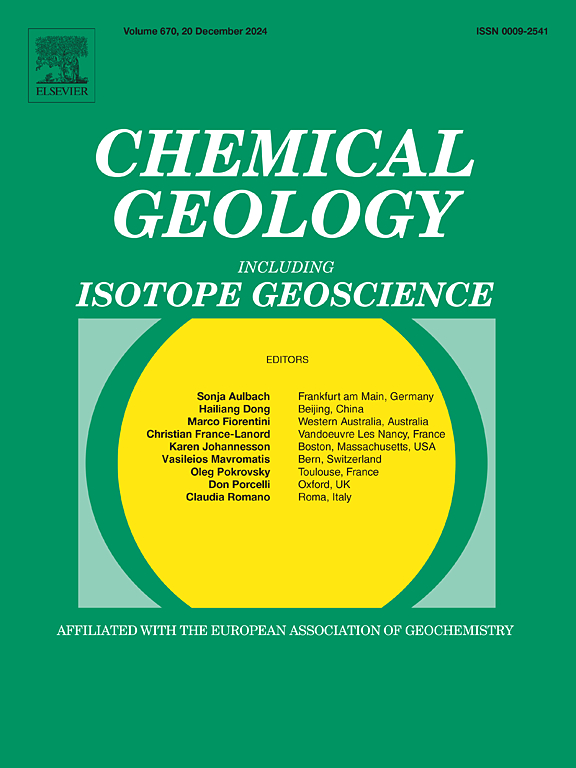Laser ablation K-Ar dating of illite on oriented aggregate mounts
IF 3.6
2区 地球科学
Q1 GEOCHEMISTRY & GEOPHYSICS
引用次数: 0
Abstract
Illite, a clay mineral formed during diagenesis and low-grade metamorphism, can be dated using the K-Ar method to reconstruct the chronological history of sedimentary basins, fault and fold formation, and hydrothermal alterations. However, conventional K-Ar and Ar-Ar dating of illite faces challenges due to the clay's small grain size, hygroscopicity, limited availability in finer fractions, and other analytical issues. This study proposes a modified K-Ar dating approach that uses a laser ablation technique to date small amounts of oriented clay aggregate mounts separated by grain size fractions and prepared on glass discs.
Four groups of illite-bearing samples from various geological settings were analyzed, ranging in age from 350 Ma to 40 Ma. X-ray diffraction of the aggregate mounts revealed different mineral compositions, with illite proportions between 20 % and 90 %, along with kaolinite, chlorite, quartz, and feldspars in some samples. The K-Ar dating setup includes ultrahigh vacuum laser ablation of oriented clay mounts combined with LIBS spectroscopy for potassium measurement and noble gas mass spectrometry for argon quantification within the same experiment. Ages were obtained through various methods (single craters, lines, and multiple craters), making the isochron method utilizing multiple craters the most precise and accurate.
This innovative K-Ar method simplifies the dating of clay fractions by avoiding problematic issues such as drying, weighing, homogeneity, and Ar recoil during irradiation while enabling mineralogical characterization through X-ray diffraction on the same sample preparation. This approach offers new insights into the geological history recorded by clay minerals. During this work, we identified unknown issues concerning sample preparation and geochronological data, including differential clay sedimentation during drying and the associated age dispersion in clays from detrital samples.

激光烧蚀定向骨架上伊利石的 K-Ar 年代测定
伊利石是一种形成于成岩作用和低变质作用时期的粘土矿物,利用K-Ar法可以重建沉积盆地、断裂和褶皱形成以及热液蚀变的年代史。然而,传统的K-Ar和Ar-Ar定年伊利石面临着挑战,因为粘土的粒度小,吸湿性,更细的分数有限,以及其他分析问题。本研究提出了一种改进的K-Ar测年方法,该方法使用激光烧蚀技术对制备在玻璃圆盘上的少量定向粘土集料进行测年。分析了来自不同地质背景的四组含伊利石样品,年龄从350 Ma到40 Ma不等。x射线衍射显示了不同的矿物组成,伊利石的比例在20%到90%之间,一些样品中还含有高岭石、绿泥石、石英和长石。K-Ar定年装置包括定向粘土支架的超高真空激光烧蚀,结合LIBS光谱测量钾和惰性气体质谱法在同一实验中定量氩。通过多种方法(单陨石坑、线和多个陨石坑)获得年龄,使得利用多个陨石坑的等时线方法最精确和准确。这种创新的K-Ar方法通过避免辐照过程中的干燥、称重、均匀性和Ar反冲等问题,简化了粘土组分的测年,同时通过x射线衍射对相同的样品制备进行矿物学表征。这种方法为研究粘土矿物记录的地质历史提供了新的见解。在这项工作中,我们发现了关于样品制备和地质年代学数据的未知问题,包括干燥过程中的差异粘土沉积和碎屑样品中粘土的相关年龄分散。
本文章由计算机程序翻译,如有差异,请以英文原文为准。
求助全文
约1分钟内获得全文
求助全文
来源期刊

Chemical Geology
地学-地球化学与地球物理
CiteScore
7.20
自引率
10.30%
发文量
374
审稿时长
3.6 months
期刊介绍:
Chemical Geology is an international journal that publishes original research papers on isotopic and elemental geochemistry, geochronology and cosmochemistry.
The Journal focuses on chemical processes in igneous, metamorphic, and sedimentary petrology, low- and high-temperature aqueous solutions, biogeochemistry, the environment and cosmochemistry.
Papers that are field, experimentally, or computationally based are appropriate if they are of broad international interest. The Journal generally does not publish papers that are primarily of regional or local interest, or which are primarily focused on remediation and applied geochemistry.
The Journal also welcomes innovative papers dealing with significant analytical advances that are of wide interest in the community and extend significantly beyond the scope of what would be included in the methods section of a standard research paper.
 求助内容:
求助内容: 应助结果提醒方式:
应助结果提醒方式:


